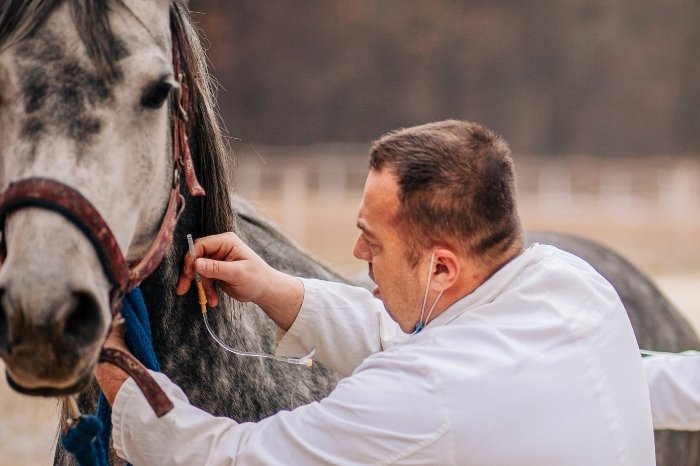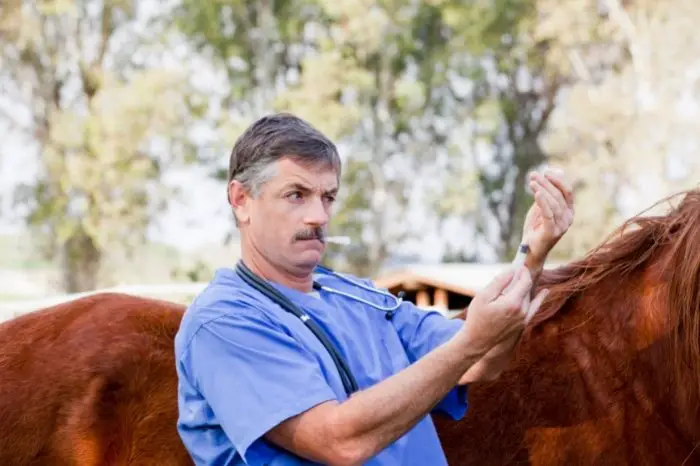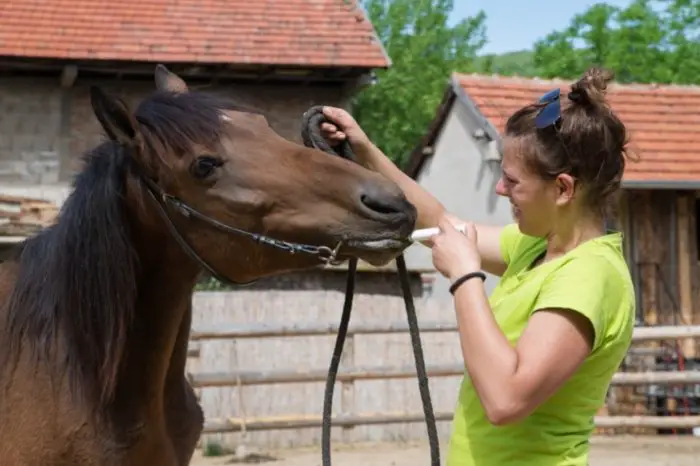Last Updated on December 27, 2022
Banamine is one of those wonder drugs that horse veterinarians simply wouldn’t be without! When it comes to controlling pain, Banamine is very effective and can be given in various ways. But how do you know how much Banamine to give a horse?
What Is Banamine?
The first and most important thing to remember is that Banamine is a prescription-only medication. That means that the use of Banamine is tightly controlled by veterinarians, and you should never administer it to your horse unless advised to by a veterinary clinician.
Banamine is the trade name for a drug called flunixin. It is a potent drug that is used to treat pain, fever, and inflammation. After administration, it normally takes effect within one to two hours.

Flunixin, or Banamine, works by blocking the production of chemicals that stimulate the inflammatory response. This type of drug is called an anti-inflammatory, and it is classified in a group of drugs called non-steroidal anti-inflammatories (NSAIDs).
What Is Banamine Used For?
Banamine is most commonly used to treat the painful symptoms of colic. Colic occurs when a horse has a gastrointestinal upset – basically, tummy ache! Banamine is very effective at relieving the pain caused by colic but must only be administered by a veterinarian.
This wonder drug is also used to protect horses from septic shock, also called endotoxic shock. To achieve this it is given at an altered dose rate when the horse is suffering from conditions such as peritonitis, diarrhea, or endometritis.
Flunixin is also very effective as an anti-inflammatory for horses suffering from painful eye conditions.
Although Banamine is classified as an NSAID, it is not normally used to treat arthritis or other long-term musculoskeletal problems. It can be used to treat severe or sudden-onset lameness and to relieve acutely painful conditions such as laminitis.
How Is Banamine Administered To Horses?
Banamine is a versatile drug that can be administered in many different ways. Some of these routes of Administration are only used by veterinary personnel, while others may be used by horse owners and carers.
Banamine, or flunixin, can be given to horses using the following methods:
- Intravenous Injection – This is the fastest-acting method of giving Banamine, and can only be administered by veterinary personnel.
- Intramuscular Injection – Intramuscular injection is rarely used to give Banamine, as it can often cause injection site reactions.
- Oral Paste – Banamine paste is often dispensed to horse owners to administer at home.
- Oral Powder – Banamine itself is not available as a powder, however, some other drug manufacturers produce a powdered form of flunixin.
How Much Banamine To Give A Horse?
When deciding how much Banamine to give a horse, it is vital to consult with a veterinary surgeon first. This is because they will know if it is safe to give this medication to your horse and if it is the right medication for your horse at that time.
There are two potential problems you could cause by giving Banamine to your horse without consulting your veterinarian.

Firstly, Banamine is such a good painkiller that it may mask the symptoms your horse is showing. So, if your horse is suffering from severe colic, it may appear less poorly than it really is. A lame horse may run around and make an injury even worse if Banamine is given without veterinary advice.
The other reason you should not give Banamine unless it is dispensed by your veterinarian is that it could cause a toxic reaction in your horse. This is a very potent drug and can cause damage to the internal organs, particularly if the horse is sick or dehydrated. It may cause a bad reaction if administered with other medications.
What Is The Banamine Dosage For Horses Orally?
In theory, it is possible to give the injectable form of Banamine as an oral medication. This can be useful in an emergency, and if your horse is difficult to inject. However, the injectable form of Banamine tastes very unpleasant. Your horse would undoubtedly prefer the paste form instead! To give injectable Banamine orally, administer the same dose as the intravenous dose.
What Is The Banamine Paste Dosage For Horses?
A single Banamine paste syringe is calibrated in twelve weight increments of 250 pounds each. So, you will need to give your horse one increment per every 250 pounds bodyweight.
So, to calculate the dose of Banamine paste you need to know the weight of your horse. Veterinary surgeons are much more experienced at estimating the weight of horses than most of us, so if you are really not sure, just ask!
Most horse owners do not have a set of scales suitable for weighing a horse. This means we need to find other ways to find out the weight of a horse. Your local veterinary clinic may have some horse weighing scales, or there could be a weighbridge you can take your horse to.
If you don’t have access to any scales, then there are some other ways to check the weight of a horse:
A device called a weigh tape can be used to calculate the weight of a horse. This is a specialized measuring tape, that gives you an estimation of the weight of the horse based on the girth measurement.
You can also use a normal measuring tape to take a specific set of measurements. Using a formula, these measurements are used to calculate the body weight of the horse.
What Is The Banamine Paste Dosage For Horses With Colic?
The Banamine paste dosage for horses with colic must only ever be calculated by a veterinarian. This is because, if given wrongly, Banamine can be very dangerous for horses with colic.
Although it may be very distressing to see your horse with colic, do not be tempted to give them that syringe of Banamine paste left on the shelf. It might well fix the colic, but it could also mask a severe problem or cause toxic side effects to your horse.

When Should I Give My Horse Banamine?
Banamine is a prescription-only medication used to relieve pain in horses. It is classified as a non-steroidal anti-inflammatory drug and is one of the most potent medications available in this category.
Because Banamine is prescription-only, it should only ever be given to a horse under the direction of a veterinarian. This is because, if used incorrectly, Banamine could mask the signs of serious illness, or cause long-lasting side effects.
For example, if Banamine is given to a horse that is suffering from colic, the horse will most likely start to look more comfortable. However, the cause of the colic may still be present, and the condition could be much worse when the painkilling action of the medication has worn off.
So, if a friend recommends that you give your horse Banamine, speak to your veterinarian first. They will be able to advise you as to whether Banamine is the best drug to use in any specific situation, and also help you work out the optimum dose to use.
Can Banamine Cause a Horse to Sweat?
Although some horse owners report that their horse has started to sweat after being given Banamine, this is not a common or widely-reported side effect of this medication. Banamine is normally given to horses that are in pain. Pain in horses can cause them to sweat, so it may be that the sweating is caused by the pain rather than the medication.
However, if your horse does sweat after being given Banamine, it is a good idea to tell your veterinarian. It may be that your horse is sensitive to medication such as Banamine, and the dosage may need to be altered in the future.
Can You Give Banamine While Giving Previcox to a Horse?
Banamine and previcox are both non-steroidal anti-inflammatory (NSAID) medications used to treat pain in horses. Because these drugs both carry similar risks of side effects and are metabolized in the same way, they should never be given at the same time without the advice of your veterinarian.
NSAIDs are very useful drugs that are widely used in horses, but their use does come with some risks. They can cause damage to the gastrointestinal system, kidneys, and liver, particularly when given to horses that are dehydrated or have underlying medical conditions.
Can Horses Eat After Banamine?
Banamine is a potent painkiller given to horses suffering from conditions such as colic, lameness, and laminitis. Horses can be fed before or after receiving Banamine, apart from in some specific situations.
The most common time when food is withheld from horses that have been given Banamine is when they are suffering from colic. Colic is a symptom of gastrointestinal problems of the horse, and Banamine is given to ease the pain. However, it is so effective that the horse can look absolutely fine, but the cause of the colic is still present!
If your horse has a bout of colic, Banamine or another painkiller will quickly ease the pain. However, your veterinarian may advise withholding food for a few hours to make sure the colic does not return when the effect of the painkiller medication wears off.
Can You Give a Horse Dexamethasone and Banamine?
Both dexamethasone and Banamine are prescription-only drugs, meaning they cannot be given without the authorization of a veterinarian. The reason for this is that these potent drugs can have severe side effects if used incorrectly, potentially resulting in long-term illness or even the death of the horse.
These effects are often greatly increased when two or more medications are used together. For example, using dexamethasone and Banamine together in a horse may increase the chance of gastric ulcers. If your veterinarian feels that using these medications together is the best option for your horse, they will talk through the potential risks with you first.
Summary
As we have learned, Banamine is a very effective painkiller that should only be prescribed by a veterinarian. When working out how much Banamine to give a horse, your veterinarian will need to figure out how much your horse weighs and the best way to administer it. Your veterinarian may dispense an extended course of Banamine for you to give to your horse orally.
We’d love to hear about your experiences – has your veterinarian ever prescribed Banamine for your horse? Or maybe you have questions about how to give Banamine to a horse? Add a comment below this post and we’ll get back to you!
What is the difference between Banamine and Bute for horses?
Bute and Banamine are both a nonsteroidal anti-inflammatory drugs (NSAID), used to treat acute pain. However, they are usually used for different purposes. Normally Bute is administered for musculoskeletal pain, such as lameness, while Banamine is often given for smooth muscle pain resulting from colic, or ocular discomfort caused by corneal ulcers.
Both drugs are considered safe to administer to foals and adult horses but can only be used for a short duration of time because prolonged use can result in stomach ulcers or kidney and liver problems. Bute was first approved by the FDA in 1959, and Banamine was approved in 1973. Both are available in oral and injectable forms. Bute has also been approved for use in cats.
When do you give a horse Banamine?
If a horse has colic, the veterinarian will most likely recommend Banamine. Banamine contains the active ingredient called Flunixin Meglumine. Flunixin Meglumine is a potent analgesic, antipyretic, and anti-inflammatory drug. NSAIDs work by inhibiting the body’s production of prostaglandins and other chemicals that stimulate the body’s inflammatory response. Flunixin is often used in horses with colic to relieve signs and provide pain relief. You should be aware that flunixin can only be used for a short period of time and it is not a substitute for proper veterinary care. If a horse has been diagnosed with colic, it is important that the veterinarian give you directions on how to properly administer the drug. This will help you to avoid giving too much or too little of the drug and avoid additional problems that could result from incorrect dosage.
What happens if you give a horse too much Banamine?
Banamine works by blocking nerve impulses that cause pain. The drug is administered intravenously, but it also can be given orally as an anti-inflammatory agent. If a horse is given too much Banamine, it can result in Banamine toxicity which can trigger a kidney failure. Kidney failure in horses is life-threatening and requires immediate veterinary attention. Other signs of Banamine toxicity include depression, loss of appetite, excessive drinking, weakness, vomiting, diarrhea, lethargy, seizures, muscle tremors, difficulty breathing, and abnormal heart beat. Benamine can also cause gastro-intestinal ulceration and should therefore be used with caution in horses that are prone to ulcers. Horses are more susceptible to Banamine toxicity when dehydrated, so make sure your horse always has the access to fresh water when taking medication.
Can you give Banamine and Bute together?
You should not mix the two medications together. A horse should never be given more than one NSAID drug at the same time as it may result in an overdose and make the situation worse. If your vet prescribed a Banamine dose for your horse, please do not change it and carefully follow instructions given by a veterinarian. It’s important to understand that Banamine should be used only when necessary and never for long periods of time. It’s also important to understand that Banamine can cause serious side effects, including liver damage and kidney failure.

Kate Chalmers is a qualified veterinary nurse who has specialized in horse care for the vast majority of her career. She has been around horses since she was a child, starting out riding ponies and helping out at the local stables before going on to college to study Horse Care & Management. She has backed and trained many horses during her lifetime and competed in various equestrian sports at different levels.
After Kate qualified as a veterinary nurse, she provided nursing care to the patients of a large equine veterinary hospital for many years. She then went on to teach horse care and veterinary nursing at one of the top colleges in the country. This has led to an in-depth knowledge of the care needs of horses and their various medical ailments, as well as a life-long passion for educating horse owners on how to provide the best possible care for their four-legged friends.
Kate Chalmers BSc (Hons) CVN, Dip AVN (Equine) Dip HE CVN EVN VN A1 PGCE

